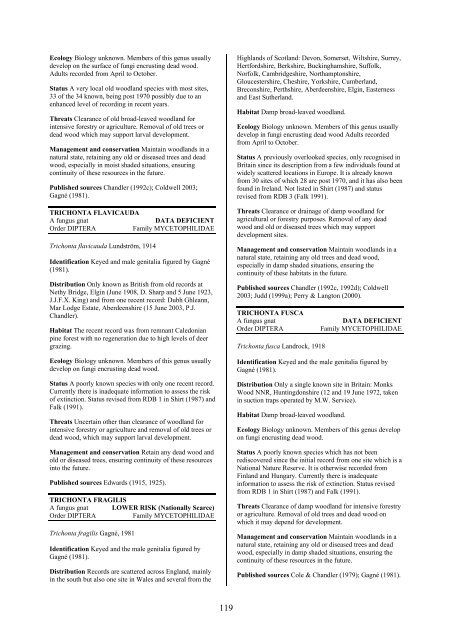Part 2: Nematocera and Aschiza not dealt with by Falk (1991) - JNCC
Part 2: Nematocera and Aschiza not dealt with by Falk (1991) - JNCC
Part 2: Nematocera and Aschiza not dealt with by Falk (1991) - JNCC
You also want an ePaper? Increase the reach of your titles
YUMPU automatically turns print PDFs into web optimized ePapers that Google loves.
Ecology Biology unknown. Members of this genus usually<br />
develop on the surface of fungi encrusting dead wood.<br />
Adults recorded from April to October.<br />
Status A very local old woodl<strong>and</strong> species <strong>with</strong> most sites,<br />
33 of the 34 known, being post 1970 possibly due to an<br />
enhanced level of recording in recent years.<br />
Threats Clearance of old broad-leaved woodl<strong>and</strong> for<br />
intensive forestry or agriculture. Removal of old trees or<br />
dead wood which may support larval development.<br />
Management <strong>and</strong> conservation Maintain woodl<strong>and</strong>s in a<br />
natural state, retaining any old or diseased trees <strong>and</strong> dead<br />
wood, especially in moist shaded situations, ensuring<br />
continuity of these resources in the future.<br />
Published sources Ch<strong>and</strong>ler (1992c); Coldwell 2003;<br />
Gagné (1981).<br />
TRICHONTA FLAVICAUDA<br />
A fungus gnat<br />
DATA DEFICIENT<br />
Order DIPTERA<br />
Family MYCETOPHILIDAE<br />
Trichonta flavicauda Lundström, 1914<br />
Identification Keyed <strong>and</strong> male genitalia figured <strong>by</strong> Gagné<br />
(1981).<br />
Distribution Only known as British from old records at<br />
Nethy Bridge, Elgin (June 1908, D. Sharp <strong>and</strong> 5 June 1923,<br />
J.J.F.X. King) <strong>and</strong> from one recent record: Dubh Ghleann,<br />
Mar Lodge Estate, Aberdeenshire (15 June 2003, P.J.<br />
Ch<strong>and</strong>ler).<br />
Habitat The recent record was from remnant Caledonian<br />
pine forest <strong>with</strong> no regeneration due to high levels of deer<br />
grazing.<br />
Ecology Biology unknown. Members of this genus usually<br />
develop on fungi encrusting dead wood.<br />
Status A poorly known species <strong>with</strong> only one recent record.<br />
Currently there is inadequate information to assess the risk<br />
of extinction. Status revised from RDB 1 in Shirt (1987) <strong>and</strong><br />
<strong>Falk</strong> (<strong>1991</strong>).<br />
Threats Uncertain other than clearance of woodl<strong>and</strong> for<br />
intensive forestry or agriculture <strong>and</strong> removal of old trees or<br />
dead wood, which may support larval development.<br />
Management <strong>and</strong> conservation Retain any dead wood <strong>and</strong><br />
old or diseased trees, ensuring continuity of these resources<br />
into the future.<br />
Published sources Edwards (1915, 1925).<br />
TRICHONTA FRAGILIS<br />
A fungus gnat LOWER RISK (Nationally Scarce)<br />
Order DIPTERA<br />
Family MYCETOPHILIDAE<br />
Trichonta fragilis Gagné, 1981<br />
Identification Keyed <strong>and</strong> the male genitalia figured <strong>by</strong><br />
Gagné (1981).<br />
Distribution Records are scattered across Engl<strong>and</strong>, mainly<br />
in the south but also one site in Wales <strong>and</strong> several from the<br />
Highl<strong>and</strong>s of Scotl<strong>and</strong>: Devon, Somerset, Wiltshire, Surrey,<br />
Hertfordshire, Berkshire, Buckinghamshire, Suffolk,<br />
Norfolk, Cambridgeshire, Northamptonshire,<br />
Gloucestershire, Cheshire, Yorkshire, Cumberl<strong>and</strong>,<br />
Breconshire, Perthshire, Aberdeenshire, Elgin, Easterness<br />
<strong>and</strong> East Sutherl<strong>and</strong>.<br />
Habitat Damp broad-leaved woodl<strong>and</strong>.<br />
Ecology Biology unknown. Members of this genus usually<br />
develop in fungi encrusting dead wood Adults recorded<br />
from April to October.<br />
Status A previously overlooked species, only recognised in<br />
Britain since its description from a few individuals found at<br />
widely scattered locations in Europe. It is already known<br />
from 30 sites of which 28 are post 1970, <strong>and</strong> it has also been<br />
found in Irel<strong>and</strong>. Not listed in Shirt (1987) <strong>and</strong> status<br />
revised from RDB 3 (<strong>Falk</strong> <strong>1991</strong>).<br />
Threats Clearance or drainage of damp woodl<strong>and</strong> for<br />
agricultural or forestry purposes. Removal of any dead<br />
wood <strong>and</strong> old or diseased trees which may support<br />
development sites.<br />
Management <strong>and</strong> conservation Maintain woodl<strong>and</strong>s in a<br />
natural state, retaining any old trees <strong>and</strong> dead wood,<br />
especially in damp shaded situations, ensuring the<br />
continuity of these habitats in the future.<br />
Published sources Ch<strong>and</strong>ler (1992c, 1992d); Coldwell<br />
2003; Judd (1999a); Perry & Langton (2000).<br />
TRICHONTA FUSCA<br />
A fungus gnat<br />
Order DIPTERA<br />
Trichonta fusca L<strong>and</strong>rock, 1918<br />
DATA DEFICIENT<br />
Family MYCETOPHILIDAE<br />
Identification Keyed <strong>and</strong> the male genitalia figured <strong>by</strong><br />
Gagné (1981).<br />
Distribution Only a single known site in Britain: Monks<br />
Wood NNR, Huntingdonshire (12 <strong>and</strong> 19 June 1972, taken<br />
in suction traps operated <strong>by</strong> M.W. Service).<br />
Habitat Damp broad-leaved woodl<strong>and</strong>.<br />
Ecology Biology unknown. Members of this genus develop<br />
on fungi encrusting dead wood.<br />
Status A poorly known species which has <strong>not</strong> been<br />
rediscovered since the initial record from one site which is a<br />
National Nature Reserve. It is otherwise recorded from<br />
Finl<strong>and</strong> <strong>and</strong> Hungary. Currently there is inadequate<br />
information to assess the risk of extinction. Status revised<br />
from RDB 1 in Shirt (1987) <strong>and</strong> <strong>Falk</strong> (<strong>1991</strong>).<br />
Threats Clearance of damp woodl<strong>and</strong> for intensive forestry<br />
or agriculture. Removal of old trees <strong>and</strong> dead wood on<br />
which it may depend for development.<br />
Management <strong>and</strong> conservation Maintain woodl<strong>and</strong>s in a<br />
natural state, retaining any old or diseased trees <strong>and</strong> dead<br />
wood, especially in damp shaded situations, ensuring the<br />
continuity of these resources in the future.<br />
Published sources Cole & Ch<strong>and</strong>ler (1979); Gagné (1981).<br />
119
















